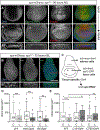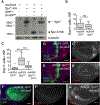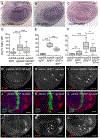Spatially Restricted Regulation of Spätzle/Toll Signaling during Cell Competition
- PMID: 30146479
- PMCID: PMC6156939
- DOI: 10.1016/j.devcel.2018.08.001
Spatially Restricted Regulation of Spätzle/Toll Signaling during Cell Competition
Abstract
Cell competition employs comparisons of fitness to selectively eliminate cells sensed as less healthy. In Drosophila, apoptotic elimination of the weaker "loser" cells from growing wing discs is induced by a signaling module consisting of the Toll ligand Spätzle (Spz), several Toll-related receptors, and NF-κB factors. How this module is activated and restricted to competing disc cells is unknown. Here, we use Myc-induced cell competition to demonstrate that loser cell elimination requires local wing disc synthesis of Spz. We identify Spz processing enzyme (SPE) and modular serine protease (ModSP) as activators of Spz-regulated competitive signaling and show that "winner" cells trigger elimination of nearby WT cells by boosting SPE production. Moreover, Spz requires both Toll and Toll-8 to induce apoptosis of wing disc cells. Thus, during cell competition, Spz-mediated signaling is strictly confined to the imaginal disc, allowing errors in tissue fitness to be corrected without compromising organismal physiology.
Keywords: Drosophila; Myc; Spätzle; Toll receptors; cancer; cell competition; growth and development; inflammation; wing imaginal disc; “cheaters”.
Copyright © 2018 Elsevier Inc. All rights reserved.
Conflict of interest statement
Declaration of Interests
The authors declare no competing interests.
Figures







Comment in
-
Super-Competitors Game the Fitness Sensing System.Dev Cell. 2018 Sep 24;46(6):672-674. doi: 10.1016/j.devcel.2018.09.006. Dev Cell. 2018. PMID: 30253165
References
-
- Anderson KV, Bokla L, and Nusslein-Volhard C (1985). Establishment of dorsal ventral polarity in the Drosophila embryo: the induction of polarity by the Toll gene product. Cell 42, 791–798. - PubMed
-
- Anderson KV, and Nusslein-Volhard C (1984). Information for the dorsal--ventral pattern of the Drosophila embryo is stored as maternal mRNA. Nature 311, 223–227. - PubMed
-
- Brodsky MH, Nordstrom W, Tsang G, Kwan E, Rubin GM, and Abrams JM (2000). Drosophila p53 binds a damage response element at the reaper locus. Cell 101, 103–113. - PubMed
Publication types
MeSH terms
Substances
Grants and funding
LinkOut - more resources
Full Text Sources
Other Literature Sources
Molecular Biology Databases

